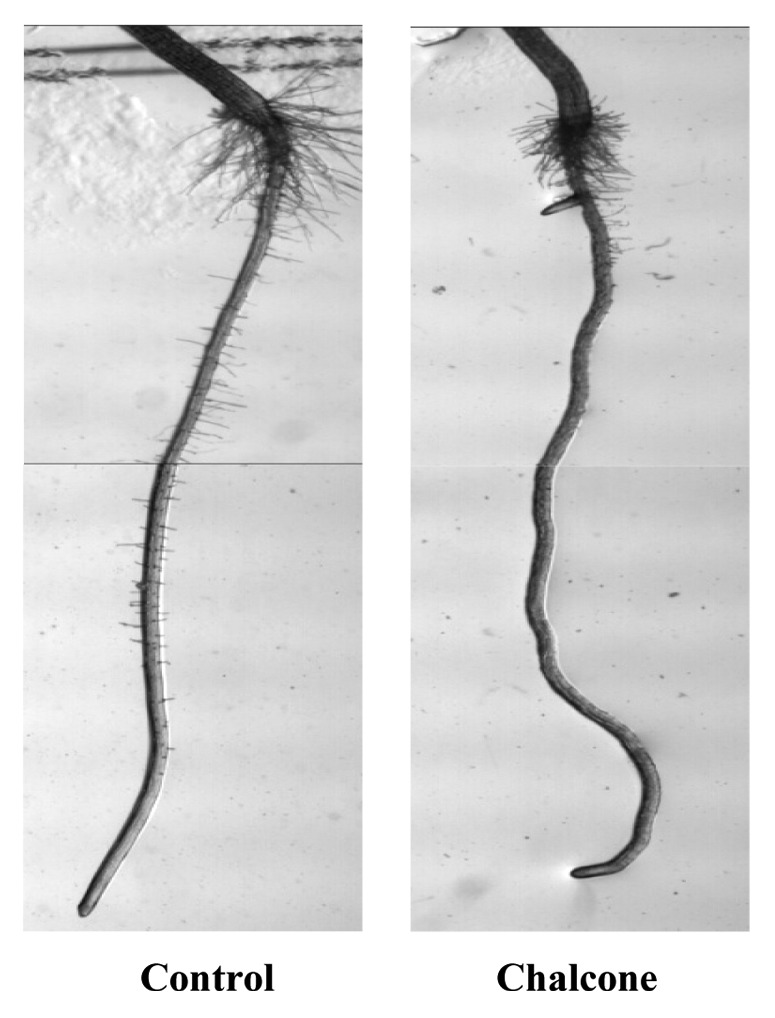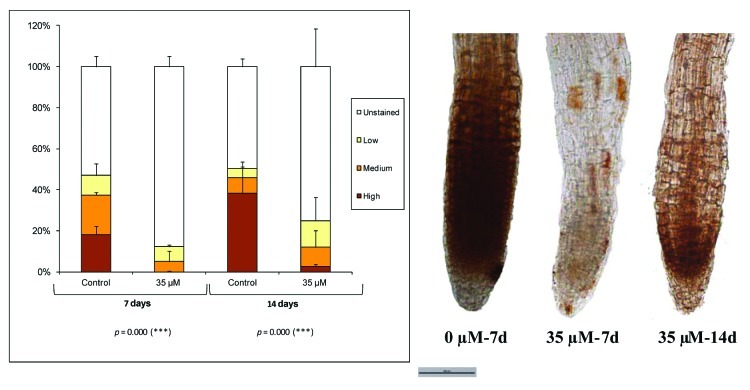Abstract
Chalcone is a secondary metabolite belonging to the group of flavonoids. It has shown strong phytotoxic activity on Arabidopsis roots, as inductor of programmed cell death, and inhibitor of root growth and root hair formation. Peroxidases are particularly abundant in root meristems and are involved in the formation and interconversion of reactive oxygen species (ROS), which play a critical role on root and root hair development. Therefore, we report here the role of peroxidases in Arabidopsis root development during chalcone treatment. A strong inhibition of peroxidase activity was detected in the apical root meristems after chalcone treatment, which reflects the important role of these enzymes on the mode of action of this secondary metabolite.
Keywords: Arabidopsis, ROS, chalcone, growth inhibition, peroxidase, root
Peroxidases are present in all organs and almost all tissues, but they are particularly abundant in roots.1 These enzymes are particularly implicated in cell wall modifications with a double role, as they can promote cell elongation by mediating in cell wall loosening or, by contrary, contribute to the stiffening of the cell wall, preventing cell growth.1 Peroxidases play a key role in the formation of reactive oxygen species (ROS), which are implicated in promoting or inhibiting cell growth and elongation. Elongation and meristematic zones are rich in O2•–, which in combination with peroxidases, can produce OH• necessary for cell wall loosening2,3 and cell growth and elongation,4 while in the differentiation zone, where cell elongation ceases and root hairs are formed, the predominating ROS is H2O2.
During the formation of root hairs, the production of ROS is crucial in order to get wall loosening and root hair growth. The absence or the abnormal growth of root hairs can be directly related with an altered production of ROS in the roots. Many natural products have been found to induce the increase or decrease of ROS production with the concomitant altered oxidant status in the plants.5-7
Trans-chalcone is a phenolic compound recently found to induce programmed-cell death in Arabidopsis thaliana roots.8 As well, abnormal and reduced root hair growth was found after chalcone treatment, which could be related to altered ROS production after chalcone treatment. To report the effects of chalcone on peroxidase activity of Arabidopsis root tips and its implications on root growth and development, seeds of Arabidopsis thaliana (L.) Heynh. ecotype Columbia (Col-0) were sterilized and transferred to square dishes containing agar with Murashige-Skoog nutrients (Sigma-Aldrich, St Louis, MO, USA) and 1% sucrose. Twenty-four seeds were sown per dish and placed vertically in a growth chamber at 22 ± 2°C with 8 h of light (120 µmol m−2 s−1). Chalcone (transbenzylideneacetophenone, 97%, Sigma-Aldrich) was prepared in EtOH (0.1%) and diluted in the agar up to the required concentrations tested in these experiments.
Peroxidase activity of Arabidopsis root apical meristems was measured according to Vanacker et al.9 with some modifications. An amount of 30 to 40 roots grown for 7 and 14 d with and without IC50 chalcone (35 µM)8 were used for these analyses. The incubation time was 2 h. Brown spots were analyzed with a Nikon Eclipse 800 light microscope equipped with a Sight Nikon DS-U2 camera and NIS-Elements D2.30 SP1 software. The staining procedure was done by triplicate. The images were analyzed using ImageProPlus software (Media Cybernetics Inc., Bethesda, MD, USA). Four levels of stain intensity were established (none, low, medium and high) to detect differences in peroxidase activity of the roots. The differences were contrasted using Pearson’s chi-square test.
As shown in Figure 1, a very important reduction and abnormal distribution of root hairs was detected in Arabidopsis roots after 35 µM chalcone. As well, a strong decline was detected in the peroxidase activity of Arabidopsis apical root meristems after treatment with the secondary metabolite trans-chalcone. The activity of peroxidases was almost imperceptible already after 7 d and, although there was an increase in the peroxidase activity of chalcone-treated roots after 14 d, this increase was still less than the control (Fig. 2).
Figure 1.

Arabidopsis roots treated with 0 (control) and 35 µM chalcone. Only upper and lower parts of the roots are shown in the images. See the characteristic absence of root hairs in chalcone-treated roots.
Figure 2.
Left: integrated optical density (IOD) percentages for peroxidase activity of Arabidopsis roots after 7 and 14 d of growth with and without 35 µM chalcone (IC50). The IOD were obtained with ImageProPlus software and analyzed using Pearson’s chi-square test: chi-square = 35.384, p = 0.000 after 7 d, and chi-square = 39.103, p = 0.000 after 14 d. The asterisks indicate the degree of significance: *** p ≤ 0,001. Right: DAB staining at the apical meristems of Arabidopsis roots after chalcone treatment. Bar: 100 µm.
Peroxidases are involved in the formation and detoxification of reactive oxygen species such as H2O2, OH• and O2•-, which are necessary in many physiological and developmental processes.4 In fact, the hydroxyl radical (OH•), resulting from the peroxidase activity, seems to be one of the responsible for cell wall loosening, which is needed for cell elongation.3 The decrease of peroxidase activity in the apical root meristem could lead to a slowdown in ROS production and, as a result, a detriment of root growth. Actually, Passardi et al.10 related the decrease of the expression of two genes of class III peroxidases in A. thaliana with the inhibition of root elongation, whereas overexpression of these genes promoted root growth. These authors found a correlation between the length of the root and the length of the root cells, suggesting that the modifications of root growth were due to changes in cell elongation. Dunand et al.4 found also a reduction of peroxidase activity in roots treated with root growth inhibitors.
As shown by Díaz-Tielas et al.8 chalcone not only decreased root elongation, but also reduced the density and elongation of root hairs in the treated radicles. In our experiments, alteration of peroxidase activity in chalcone-treated Arabidopsis roots occurred at particularly low concentrations (35 μM, IC50). The decrease in peroxidase activity was detected very early, at only 7 d of growth, when most of the damages showed by Díaz-Tielas et al.8 (e.g., cell death) were not yet evident. The thickening of the root apex and the presence of a greater number but lower size of cells in treated roots supports the decline in elongation (decrease of peroxidase activity) as a result of root growth reduction.
As reactive oxygen species, such as H2O2 (precursor of OH•), are involved in root hair formation and the formation of lignin mediated by peroxidase activity,11 H2O2 production required for this process could be blocked due to inhibition of Arabidopsis peroxidases after chalcone treatment. We can conclude that the decrease of peroxidase activity detected by DAB staining in Arabidopsis root tips, especially in the elongation zone of chalcone-treated roots, could be the main responsible for the strong inhibition detected in root length and hair development. The staining patterns detected by DAB on Arabidopsis roots indicate a general and synchronized effect of chalcone on Arabidopsis seedlings at very low concentrations, emphasizing its great phytotoxic capacity.
Disclosure of Potential Conflicts of Interest
No potential conflicts of interest were disclosed.
Footnotes
Previously published online: www.landesbioscience.com/journals/psb/article/21594
References
- 1.Passardi F, Penel C, Dunand C. Performing the paradoxical: how plant peroxidases modify the cell wall. Trends Plant Sci. 2004;9:534–40. doi: 10.1016/j.tplants.2004.09.002. [DOI] [PubMed] [Google Scholar]
- 2.Chen S-X, Schopfer P. Hydroxyl-radical production in physiological reactions. A novel function of peroxidase. Eur J Biochem. 1999;260:726–35. doi: 10.1046/j.1432-1327.1999.00199.x. [DOI] [PubMed] [Google Scholar]
- 3.Liszkay A, van der Zalm E, Schopfer P. Production of reactive oxygen intermediates (O(2)(.-), H(2)O(2), and (.)OH) by maize roots and their role in wall loosening and elongation growth. Plant Physiol. 2004;136:3114–23, discussion 3001. doi: 10.1104/pp.104.044784. [DOI] [PMC free article] [PubMed] [Google Scholar]
- 4.Dunand C, Crèvecoeur M, Penel C. Distribution of superoxide and hydrogen peroxide in Arabidopsis root and their influence on root development: possible interaction with peroxidases. New Phytol. 2007;174:332–41. doi: 10.1111/j.1469-8137.2007.01995.x. [DOI] [PubMed] [Google Scholar]
- 5.Babula P, Adam V, Kizekb R, Sladký Z, Havel L. Naphthoquinones as allelochemical triggers of programmed cell death. Environ Exp Bot. 2009;65:330–7. doi: 10.1016/j.envexpbot.2008.11.007. [DOI] [Google Scholar]
- 6.Martínez-Peñalver A, Pedrol N, Reigosa MJ, Sánchez-Moreiras AM. Tolerance of Arabidopsis thaliana to the allelochemical protocatechualdehyde. J Plant Growth Regul. 2012 doi: 10.1007/s00344-011-9250-8. In press. [DOI] [Google Scholar]
- 7.Sánchez-Moreiras AM, Martínez-Peñalver A, Reigosa MJ. Early senescence induced by 2-3H-benzoxazolinone (BOA) in Arabidopsis thaliana. J Plant Physiol. 2011;168:863–70. doi: 10.1016/j.jplph.2010.11.011. [DOI] [PubMed] [Google Scholar]
- 8.Díaz-Tielas C, Graña E, Sotelo T, Reigosa MJ, Sánchez-Moreiras AM. The natural compound trans-chalcone induces programmed cell death in Arabidopsis thaliana roots. Plant Cell Environ. 2012;35:1500–17. doi: 10.1111/j.1365-3040.2012.02506.x. [DOI] [PubMed] [Google Scholar]
- 9.Vanacker H, Carver TLW, Foyer CH. Early H(2)O(2) accumulation in mesophyll cells leads to induction of glutathione during the hyper-sensitive response in the barley-powdery mildew interaction. Plant Physiol. 2000;123:1289–300. doi: 10.1104/pp.123.4.1289. [DOI] [PMC free article] [PubMed] [Google Scholar]
- 10.Passardi F, Tognolli M, De Meyer M, Penel C, Dunand C. Two cell wall associated peroxidases from Arabidopsis influence root elongation. Planta. 2006;223:965–74. doi: 10.1007/s00425-005-0153-4. [DOI] [PubMed] [Google Scholar]
- 11.Foreman J, Demidchik V, Bothwell JHF, Mylona P, Miedema H, Torres MA, et al. Reactive oxygen species produced by NADPH oxidase regulate plant cell growth. Nature. 2003;422:442–6. doi: 10.1038/nature01485. [DOI] [PubMed] [Google Scholar]



